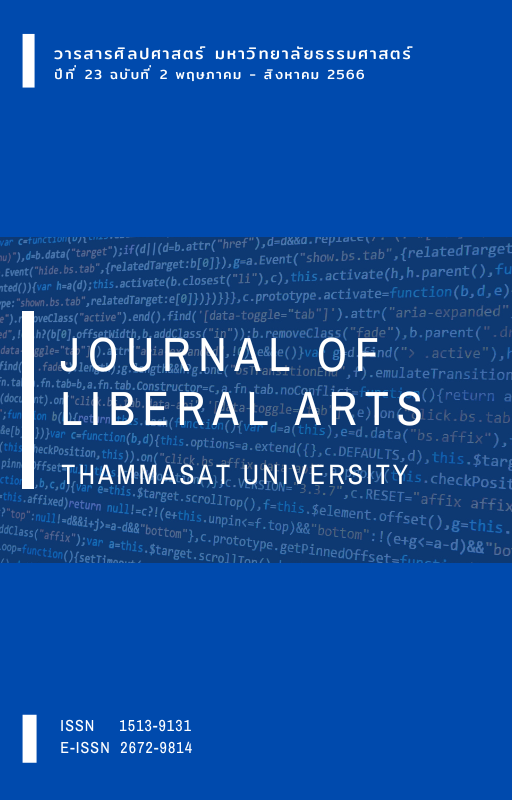โควิด-19 : การลงโทษอันศักดิ์สิทธิ์กับกลยุทธ์ความเคลื่อนไหวของกลุ่มรัฐอิสลามในเอเชียตะวันออกเฉียงใต้
Main Article Content
บทคัดย่อ
ท่ามกลางการระบาดของโควิด-19 ไม่ได้มีเพียงผู้คนเท่านั้นที่จำเป็นต้องปรับเปลี่ยนวิถีชีวิตแต่กลุ่มก่อการร้ายก็มีการปรับเปลี่ยนกลยุทธ์การเคลื่อนไหว สำหรับกลุ่ม IS การเคลื่อนไหวดังกล่าวกระทำภายใต้การโฆษณาชวนเชื่อว่าโรคระบาดครั้งนี้เป็น “บทลงโทษอันศักดิ์สิทธิ์” จากพระผู้เป็นเจ้า ดังนั้น งานวิจัยครั้งนี้จึงมีวัตถุประสงค์เพื่อศึกษากลยุทธ์การเคลื่อนไหวของกลุ่ม IS ในเอเชียตะวันออกเฉียงใต้ภายใต้สภาวการณ์ระบาดของโควิด-19 และเพื่อศึกษาผลกระทบที่เกิดกับกลุ่ม IS ใน เอเชียตะวันออกเฉียงใต้ภายใต้สภาวการณ์ระบาดของโควิด-19 โดยอาศัยแนวคิดคลื่นสี่ลูกของการก่อการร้ายสมัยใหม่ แนวคิดการโฆษณาชวนเชื่อ แนวคิดว่าด้วยเรื่องเล่า แนวคิดเรื่องทดสอบความศรัทธาต่อพระผู้เป็นเจ้า (บาลาอฺ) และแนวคิดเรื่องญิฮาดในศาสนาอิสลาม โดยงานวิจัยนี้เป็นการวิจัยเชิงคุณภาพ เป็นการศึกษาจากเอกสารและการสัมภาษณ์ ผลจากการศึกษาพบว่า ในช่วงการระบาดของเชื้อไวรัสโควิด-19 อัตราการก่อเหตุก่อการร้ายในเอเชียตะวันออกเฉียงใต้ลดน้อยลง และกลุ่มก่อการร้ายในเอเชียตะวันออกเฉียงใต้ปรับกลยุทธ์การเคลื่อนไหวโดยใช้การเผยแพร่อุดมการณ์และการโฆษณาชวนเชื่อผ่านช่องทางออนไลน์เพิ่มขึ้น อย่างไรก็ดี ภาครัฐได้ใช้ประโยชน์ในช่วงการแพร่ระบาดนี้ในการสืบสวนเฝ้าระวังและจับกุมตัวผู้ก่อการร้ายซึ่งต้องเก็บตัวอยู่ในที่พักอาศัยจากมาตรการ Lock Down ทำให้สามารถจับกุมตัวผู้ก่อการร้ายได้เป็นจำนวนมาก
Downloads
Article Details

อนุญาตภายใต้เงื่อนไข Creative Commons Attribution-NonCommercial-NoDerivatives 4.0 International License.
เอกสารอ้างอิง
ชัยวัฒน์ มีสันฐาน. ผู้อำนวยการสถาบันเอเชียตะวันออกศึกษา มหาวิทยาลัยธรรมศาสตร์. (3 กุมภาพันธ์ 2566). สัมภาษณ์.
นักวิเคราะห์นโยบายและแผนชำนาญการ. กองประเมินภัยคุกคาม สำนักงานสภาความมั่นคงแห่งชาติ. (20 มกราคม 2566). สัมภาษณ์.
นัสริน ยะหริ่ง (2565). การดะอฺวะฮฺตับลีฆ ของมุสลิมชายแดนใต้ท่ามกลางสถานการณ์การแพร่ระบาดของโรคโควิด-19 [ภาคนิพนธ์ปริญญาบัณฑิต, มหาวิทยาลัยธรรมศาสตร์]. Thammasat University Digital Collections.
ผู้เชี่ยวชาญด้านการต่อต้านการก่อการร้าย. สำนักนายกรัฐมนตรี. (15 ธันวาคม 2565). สัมภาษณ์.
ศาสนีย์ ศรศิลป์. (2563). ภัยคุกคามข้ามพรมแดนจากกลุ่มรัฐอิสลามต่อภูมิภาคเอเชียตะวันออกเฉียงใต้. ใน สถาบันเทคโนโลยีพระจอมเกล้าเจ้าคุณทหารลาดกระบัง, คณะศิลปศาสตร์, รายงานสืบเนื่องการประชุมวิชาการระดับชาติศิลปศาสตร์ประยุกต์ ครั้งที่ 9 พ.ศ. 2563 (NCAA2020) หัวข้อ Sustainability of Practice and Research in Liberal Arts (หน้า 46-47). https://la.kmitl.ac.th/ncaa-proceedings
สุภาค์พรรณ ตั้งตรงไพโรจน์. (2549). เจไอคืออะไร. openbooks
อาทิตย์ ทองอินทร์. (2560). ขบวนการรัฐอิสลาม. โรงพิมพ์วัชรินทร์ พี.พี.
Arianti, V. (2016). Indonesia. In R. Gnaratna & S. Kam (Eds.), Handbook of Terrorism in the Asia-Pacific (pp. 39-42). Imperial College Press
Azman, N. A. (2019). Evolution of Islamic State Narrative amid the Covid 19 pandemic. In S. Sim (Eds.), Home Journal, Home Team Academy (pp. 190-193). Ministry of Home Affairs Singapore.
Azman, N. A. (2020). ‘Divine Retribution’: The Islamic State’s COVID-19 Propaganda. The Diplomat. https://thediplomat.com/2020/03/divine-retribution-the-islamic-states-covid-19-propaganda/
Banlaoi, R. C. (2007). A handbook of terrorism and insurgency in Southeast Asia. A. T. H. Tan (Ed.), Radical Muslim Terrorism in the Philippines (pp. 194-243). Edward Elgar Publishing.
Barrett, R. (2017). Beyond the caliphate: Foreign fighters and the threat of returnees. Soufan Group. http://www.jstor.org/stable/resrep10782
Bilveer, S. (2007).The Talibanization of Southeast Asia losing the war on terror to Islamist extremists. Bloomsbury Publishing.
Caves J. (2019). Timeline US policy on ISIS. Wilson center. https://www.wilsoncenter.org/article/timeline-us-policy-isis
Chan, A. (2015). Malaysia. Counter Terrorist Trends and Analyses, 7(1), 13-16. http://www.jstor.org/stable/26351300
Djalante, R., Nurhidayah, L., Van Minh, H., Phuong, N. T. N., Mahendradhata, Y., Trias, A., Lassa, J., & Miller,. M. A. (2020). COVID-19 and ASEAN responses: Comparative policy analysis. Progress in Disaster Science, 8, 1-12. https://doi.org/10.1016/j.pdisas.2020.100129
Fonbuena, C. (2015, February 25). AFP orders all-out war vs BIFF. Rappler. https://www.rappler.com/nation/85007-biff-all-out-offensive/
Gayatri, I. H. (2021, July 23). Even through a pandemic, terrorism persists in Indonesia. Australian Institute of International Affairs. https://www.internationalaffairs.org.au/australianoutlook/even-through-a-pandemic-terrorism-persists-in-indonesia/
Hart, M. (2018, February 12). Bangsamoro Islamic Freedom Fighters Assume ISIS Mantle in the Philippines Troubled South. Geopoliticalmonitor Intelligence Corp. https://www.geopoliticalmonitor.com/bangsamoro-islamic-freedom-fighters-assume-isis-mantle-in-the-philippines-troubled-south/
Hwang, J. C. (2019). Relatives, redemption, and rice: Motivations for joining the maute group. CTC Sentinel, 12(8), 23-27.
Institue for Economic and Peace. (2020). Global terrorism index 2020 measuring the impact of terrorism. http://visionofhumanity.org/reports
Jadoon, A., Jahanbani, N., & Willis, C. (2020, July). Rising in the East. The Combating Terrorism Center at West Point. https://ctc.usma.edu/wp-content/uploads/2020/07/Rising-in-the-East-Report-1.pdf
Jadoon, A., Jahanbani, N., & Willis, C. (2020). The Islamic state’s operational alliances in Southeast Asia. In A. Jadoon, N. Jahanbani, & C. Willis (Eds.), Rising in the East: A regional overview of the Islamic state’s operations in Southeast Asia (pp. 31-43). Combatting Terrorism Center at West Point. http://www.jstor.org/stable/resrep26051.8
Jones, S. (2020). COVID-19 and Extremism in Southeast Asia. The Asia Pacific Journal, 18(4). 1-8.
Lewis, J. (2018, November 27). The battle of Marawi: Small team lessons learned for the close fight. Australian Army’s professional military education. The Cove. https://cove.army.gov.au/article/battle-marawi-small-team-lessons-learned-close-fight
Mapping Militant Organizations. (2018). Bangsamoro Islamic Freedom Fighters. Stanford University. https://cisac.fsi.stanford.edu/mappingmilitants/profiles/bangsomoro-islamic-freedom-fighters
Pantucci, R. (2021). Mapping the one year impact of Covid-19 on Violent Extremism. Counter Terrorism Trend and Analysis, 12(3), pp. 1-9.
Rapoport, D. C. (2013). Waves of global terrorism: From 1879 to the present. Columbia University Press.
Regan, H. (2019, January 21). Philippine vote could finally bring peace to restive region. CNN. https://edition.cnn.com/2019/01/21/asia/mindanao-referendum-peace-vote-intl/index.html
Sibalinggam, M. (2016). Malaysia. In R. Gnaratna & S. Kam (Eds.), Handbook of Terrorism in the Asia-Pacific (p. 53). Imperial College Press.
The Straits Times. (2014). Jailed Indonesian terrorist Abu Bakar Bashir has been funding ISIS: Anti-terrorism chief. The Straits Times https://www.straitstimes.com/asia/se-asia/jailed-indonesian-terrorist-abu-bakar-bashir-has-been-funding-isis-anti-terrorism-chief
Worldometers. (2023). Covid 19 Coronavirus pandemic. https://www.worldometers.info/coronavirus/?
WHO. (2020, March 11). WHO Director-General’s opening remarks at the media briefing on COVID-19 - 11 March 2020. WHO. https://www.who.int/director-general/speeches/detail/who-director-general-s-opening-remarks-at-the-media-briefing-on-covid-19---11-march-2020
Rahmah, U., Yeo, K., Dass, R., Singh, J., Mok, B., Bashar, I., Chalermsripinyorat, R., & Singam, K. V. (2023). Southeast Asia: Indonesia, Philippines, Malaysia, Myanmar, Thailand, Singapore. Counter Terrorist Trends and Analyses, 15(1), 12-49. https://www.jstor.org/stable/48707912
Rahmah, U., Yeo, K., Mahzam, R., Singh, J., Bashar, I., Pathan, D. Nasir, A. A. (2021). Southeast Asia: Indonesia, Philippines, Malaysia, Myanmar, Thailand, Singapore. Counter Terrorist Trends and Analyses, 13(1), 14-51. https://www.jstor.org/stable/26979985


